Ever feel like your B2B lead generation efforts are stuck in the Stone Age while your competitors are living in the future? You’re not alone. The old ways of drumming up business – endless cold calling, expensive sales teams, and unpredictable ad platforms – are becoming dinosaurs in our AI-powered world.
But here’s some good news: you can build an AI-powered outbound engine that consistently generates qualified leads on autopilot, and you can get it set up in just 60 days.
In this blog, we’re breaking down exactly how to create an AI-driven B2B lead generation system that will:
- Cut your cost per appointment by 70-80% compared to ads
- Generate consistent, predictable lead flow
- Require just 2-6 hours of maintenance per week
- Connect you directly with high-value decision makers
- Free you from having to hire expensive SDRs
Sounds too good to be true? It’s not, it’s just smart automation applied to proven strategies. Let’s dive in.
Why Cold Email Still Dominates B2B Lead Generation
Before we jump into the technical stuff, let’s address the elephant in the room: “Is cold email still effective in 2025?”
The answer is a resounding YES, but with a crucial caveat—it has to be done right.
Cold email remains king in B2B because it reaches people where they already live: their inbox. Can you name a single business owner who doesn’t check email daily? Neither can I.
When comparing different client acquisition channels, content marketing and organic strategies are great but take 4-6 months to build momentum. Paid ads can work, but you’re bidding on clicks with diminishing returns and giving control to platforms that change their algorithms on a whim.
Cold email, when executed strategically, gives you direct access to decision-makers and costs a fraction of other methods. The key difference between spam and successful outreach? Precision targeting and personalization, which is exactly where AI shines.
The 4-Phase System for AI-Powered Lead Generation
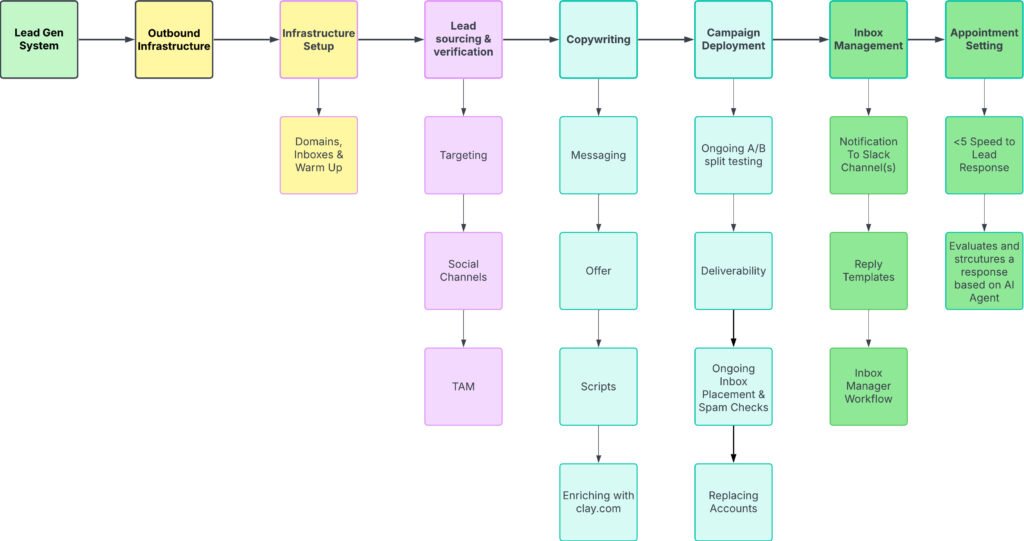
Building an AI lead generation engine isn’t about letting robots take over your entire process. It’s about using AI strategically to enhance human efforts, not replace them. This creates consistent, qualified pipelines of appointments without destroying your brand with generic, robotic-sounding messages.
Our system breaks down into four critical phases:
- Infrastructure setup
- Lead sourcing and verification
- Email copywriting
- Deployment and inbox management
Let’s break each one down.
Phase 1: Building Bulletproof Email Foundation
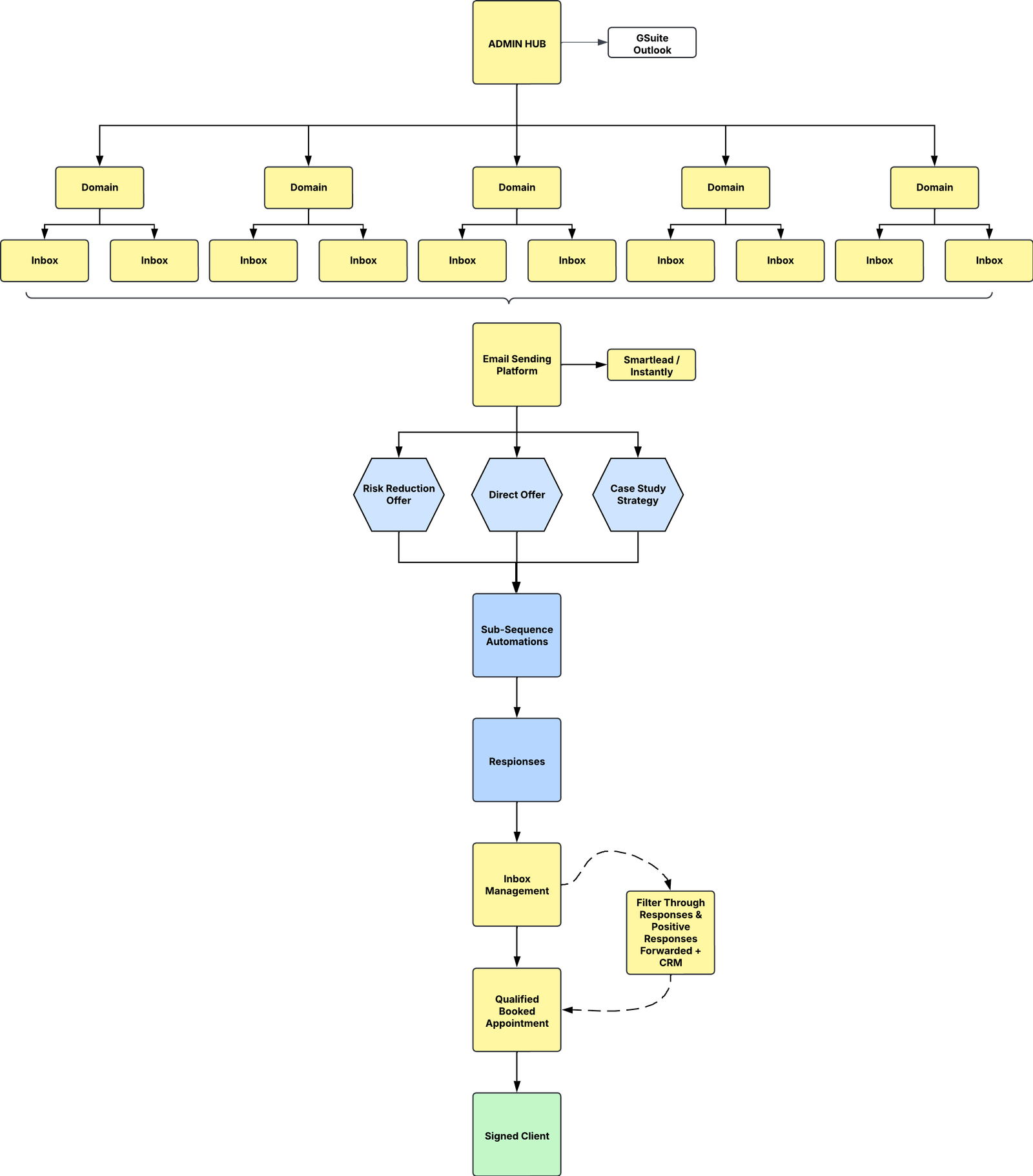
This is where 90% of outbound efforts fail before they even start. If you don’t set up your email infrastructure correctly, your carefully crafted messages will go straight to spam; or worse, damage your domain reputation.
Here’s exactly what you need to do:
- Purchase dedicated sending domains: Get fresh domains specifically for your outreach campaigns, separate from your main business domain.
- Configure proper DNS settings: Set up SPF, DKIM, and DMARC records. These technical authentication protocols signal to email providers that your messages are legitimate. Research from Cloudflare shows these protocols are crucial for building trust with Internet Service Providers and improving deliverability.
- Create and warm up inboxes: Set up 2-3 inboxes per domain and avoid free email providers or cheap alternatives like Zoho. Warm up each inbox over 14 days before sending real campaigns.
- Connect to a sending platform: Use platforms like SmartLead, Instantly, or Email Bison to centralize and manage your campaigns.
This foundation is non-negotiable. Skip it, and you might as well throw your leads and messages in the trash. Do it right, and you’ll see significantly higher inbox placement rates and more responses from day one.
Phase 2: AI-Powered Lead Sourcing and Verification
With your infrastructure in place, it’s time to build a database of ideal prospects using AI for precision and scale.
The goal: Create a database of thousands of verified decision-makers who match your ideal customer profile (ICP).

Here’s how the AI-enhanced process works:
- Use Clay for data enrichment: Clay is a powerful platform for go-to-market data that allows you to create AI agent workflows. Each column in your database can have an AI prompt that enriches your leads row by row.
- Implement the 5-step lead process:
- Search: AI agents scrape the web based on your criteria
- Ensure: Verify email information and names
- Enrich: Gather prospect data from emails and social profiles
- Validate: Match against your ICP criteria
- Narrative: Find personalized reasons to reach out
- Verify email deliverability: Only keep leads with 95%+ deliverability ratings. Anything lower gets tossed to protect your sending reputation.
The power of this approach is that AI handles the data-heavy tasks while you focus on strategy. You’re building a high-quality, verified database that becomes an asset for your business over time.
Phase 3: Creating Email Frameworks That Convert
Now that you have your infrastructure and leads, it’s time to craft messages that actually get responses.
The goal isn’t to blast generic templates: it’s to create frameworks you can personalize at scale using the data you’ve gathered. Here’s how:
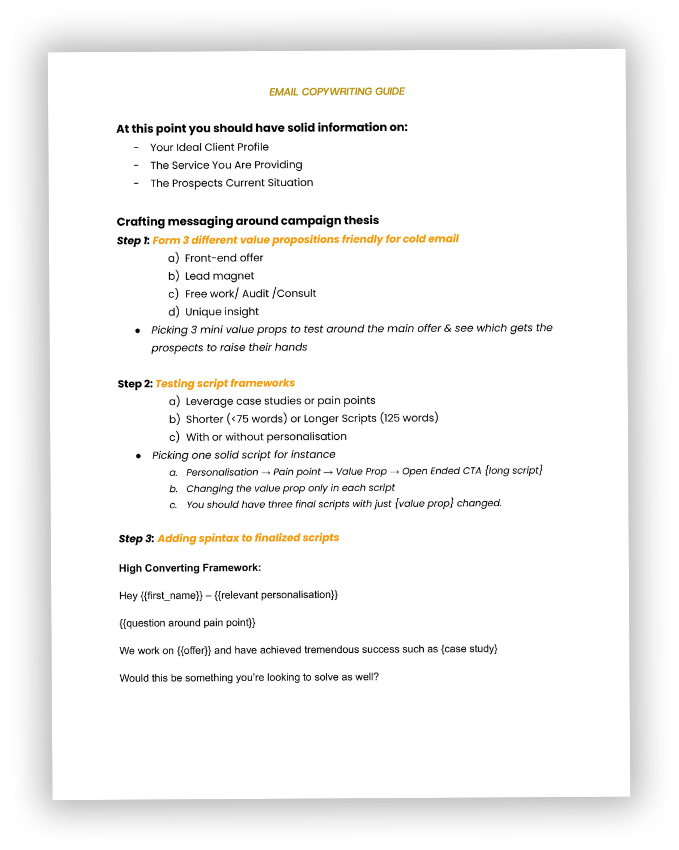
- Start with your value proposition: Define your main offer, identify your ICP, and understand your prospect’s current situation (using data from Clay).
- Create sub-offer variants: Test different angles like a front-end offer (try before you buy), free resource, or unique insight.
- Design email scripts: Create both long-form and short-form templates based on your market’s sophistication level. More sophisticated markets often respond better to longer, more detailed emails, while others prefer concise messages.
- Build follow-up sequences: This is where the gold is. Create a series of 3-4 follow-ups that add value rather than just “bumping” your previous message:
- Day 3: Value-add follow-up (share a newsletter, resource, or insight)
- Day 7: Case study demonstration
- Day 10: Pattern interrupt with a question
- Day 14: Close the loop (offer to connect with someone else)
- Implement A/B testing: Use platforms like SmartLead to automatically determine which variants perform best based on positive reply rates.
Remember: Don’t track open rates for cold emails as this can damage deliverability. Focus instead on response rates and conversations started.
Phase 4: Automated Inbox Management
The final piece of the puzzle is creating systems to handle responses efficiently. Speed to lead is critical, the faster you respond to interested prospects, the more likely they are to convert.
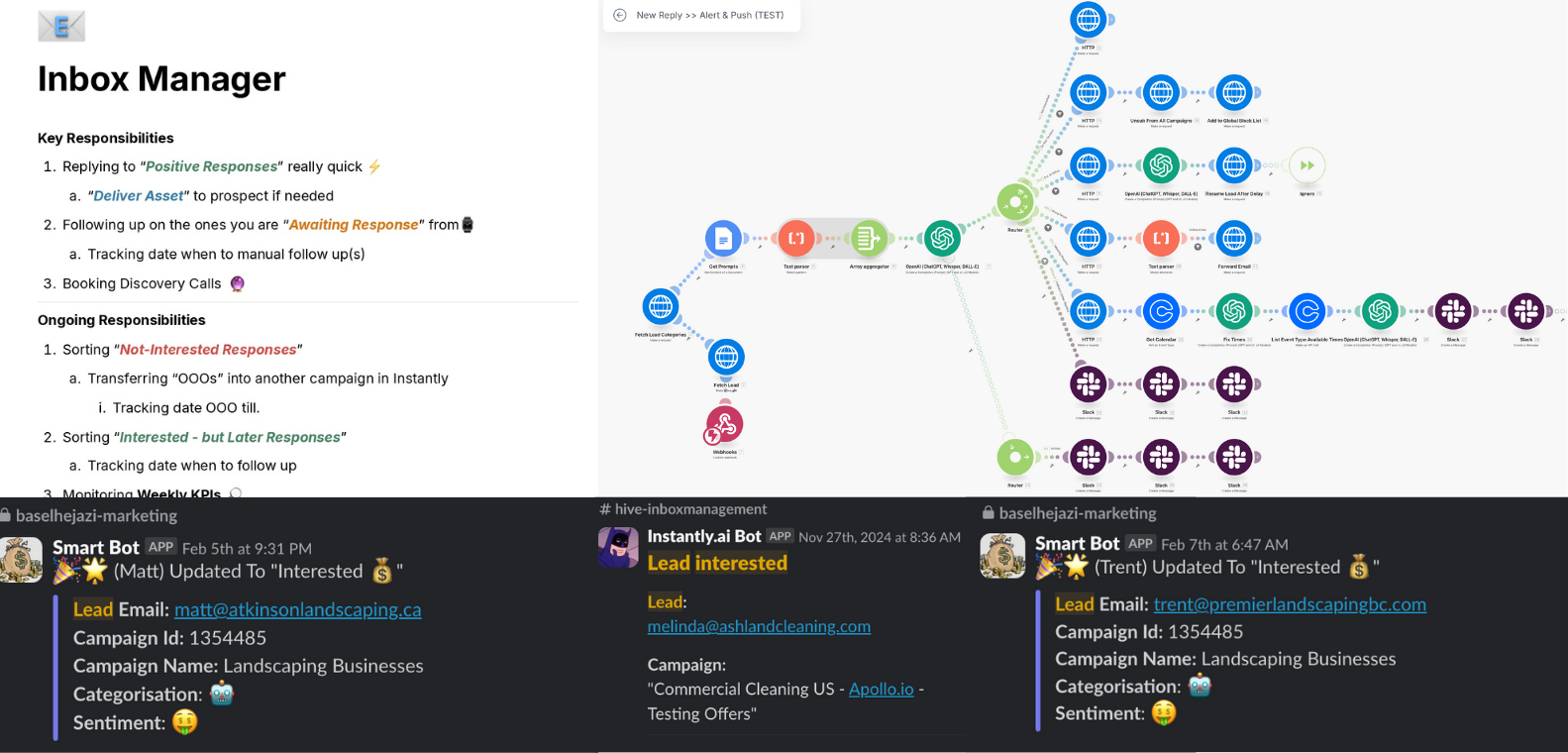
- Create response templates: Document how you handle different types of responses (interested, not interested, not now, etc.).
- Build an AI workflow: Integrate your templates into platforms like Make or Zapier with AI agents trained to categorize and respond appropriately.
- Set up notifications: Connect your workflow to Slack so you’re immediately notified of important responses.
- Add calendar integration: Enable AI to check your calendar and schedule appointments directly with interested prospects.
The results are game-changing: responses handled within minutes instead of hours, 100% follow-up rate on positive replies, and no manual sorting through hundreds of emails.
Putting It All Together: Your 60-Day Implementation Plan
To implement this AI-powered lead generation system in 60 days, follow this roadmap:
Days 1-15:
- Set up your infrastructure
- Purchase domains and configure DNS settings
- Create inboxes and begin warming them up
Days 16-30:
- Define your ICP
- Configure Clay workflows
- Begin lead sourcing and verification
Days 31-45:
- Craft email frameworks
- Create follow-up sequences
- Prepare A/B testing variants
Days 46-60:
- Launch initial campaigns
- Monitor responses and adjust
- Implement inbox management workflows
Once the system is running, you’ll just need 2-3 hours weekly for maintenance or 4-6 hours if you’re regularly setting up new campaigns.
The Cost-Benefit Analysis: Is It Worth It?
Building this system yourself is certainly possible but comes with challenges. You’ll need to:
- Learn technical aspects of email deliverability
- Master AI tools and workflows
- Create effective copy and campaigns
- Manage ongoing optimization
Alternatively, you could work with experts who’ve already perfected these systems, potentially saving months of trial and error.
Either way, the ROI compared to traditional methods is compelling:
- 70-80% lower cost per appointment than paid ads
- No need for full-time SDRs
- Predictable, consistent lead flow
- Direct access to decision-makers
Final Thoughts: The Future of B2B Lead Generation
The landscape of B2B marketing is evolving rapidly. While content marketing and paid ads have their place, AI-enhanced outbound marketing offers an edge that many businesses haven’t yet discovered.
By focusing on quality over quantity, using AI to enhance (not replace) human efforts, and building systems that run on autopilot, you can create a lead generation engine that delivers qualified prospects consistently and affordably.
The future belongs to businesses that embrace these approaches, will yours be one of them?
Frequently Asked Questions
The costs include domain purchases ($10-20 per domain), email accounts ($5-10 per inbox monthly), email sending platforms ($50-100 monthly), and data tools like Clay (starting around $100 monthly). All in, expect to invest $300-500 monthly in tools, significantly less than hiring an SDR or running extensive ad campaigns.
Yes, when done correctly. You must follow CAN-SPAM, GDPR, and other applicable regulations by including proper identification, honest subject lines, and clear unsubscribe options. The system described focuses on quality targeting and personalization, which aligns with best practices for compliance.
Start conservatively with around 15-25 emails daily per warmed-up inbox, and scale gradually. Quality matters more than quantity—150-200 highly targeted emails daily is ideal for most businesses rather than blasting thousands of generic messages.
While open tracking can harm deliverability, you can gauge effectiveness through response rates. If you’re getting responses (even negative ones), your emails are reaching inboxes. You can also set up test accounts with major providers to monitor deliverability.
No—and that’s a good thing! The most effective approach uses AI to enhance human efforts, not replace them. AI excels at data processing, personalization at scale, and workflow automation, but human oversight and strategy remain essential for building relationships and maintaining brand integrity.
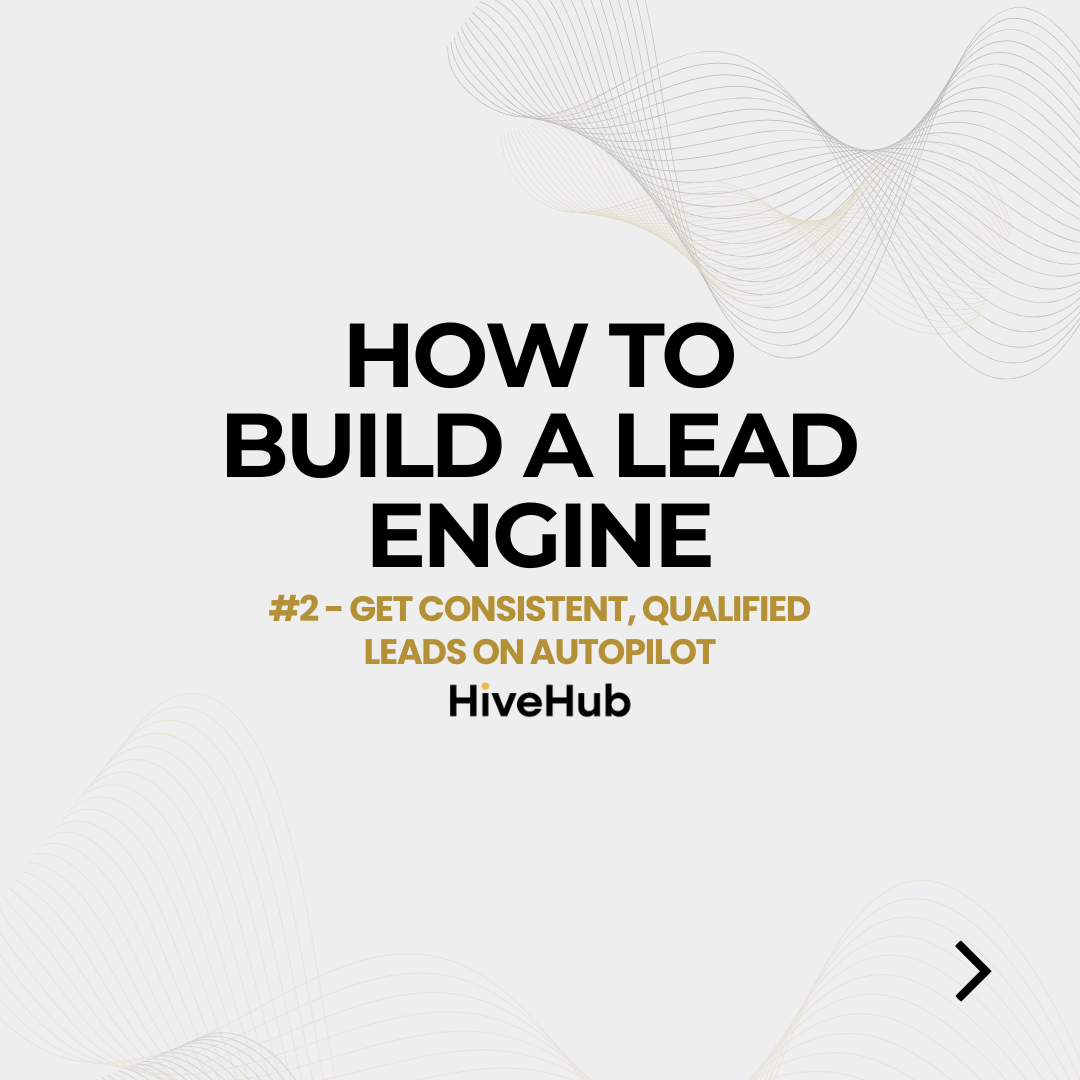
Leave a Reply